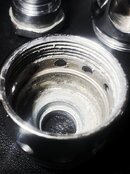Continued from previous post
Having polished the piston end, you also need to devote a little attention to the shaft. Inspect the shaft under the microscope, looking for any vertical scratches from piston insertion or removal at an angle, that may serve as pathways for leaking high pressure air. Keep in mind that piston shaft defects will not result in IP creep, but rather air bubbling from the ambient chamber holes when the reg is pressurized and submerged.
So when you get a reg for testing, make sure to do a submerged check for bubbles in addition to an IP check. If the ambient chamber bubbles, tilt the first stage while submerged, first with the LP ports up, and then with the HP end up. See if you can determine whether the bubbles come from the piston head end (piston head oring or land defect), or from the HP end (piston shaft oring or land defect). If the defect is on the HP oring land, your first stage is likely toast. Any other problem you can fix with new orings or polishing.
In any case, with this regulator, while grasping the shaft of the piston wrapped in Micromesh, twist it firmly with successively lighter grades of cloth until it is smooth under the microscope:
It is rare that you need grit coarser than 4,000 for the piston shaft. I take it all the way to 12,000 grit. It is sometimes argued that leaving the shaft satiny traps lubricant better. But any benefit from lube trapped in the coarser finish of a satin piston shaft will last only until the lube has been wiped away. I believe that a better HP o-ring seal will occur against a mirror finish, and I polish my piston shafts as smooth as I can get them. In any case, Atomic's HP o-ring is Teflon impregnated.
EDIT: My good friend
@couv has taught me that I'm wrong about polishing the piston shaft to a mirror finish. He comes from a long career dealing with this very issue in aircraft hydraulic pistons, and points out that a mirror finish will increase friction. The easiest way to think about it is that a drunk driving too fast around the corner on a cobblestone street will skid. The same drunk on a smooth road will roll his vehicle.
So maybe take the shaft to 4,000 grit in removing any scoring, and leave it at that. Your HP shaft o-ring will thank you.
Only now is the regulator ready for reassembly. After reassembly per the Service Manual (including proper torque of the HP seat retainer, the turret bolt (if any) and the yoke retainer), it is time to put the reg back on an IP gauge. Keep in mind that you have microscopically shortened your piston shaft. That means that to reach the seat, the piston/spring has to compress slightly more. Typically you won't see more than 1-2 psi IP rise. But if you take out a
deep nick, you may have to remove one or more shims to prevent the spring from compressing so much that IP rises out of specification.
There is nothing like the crisp lockup of a previously leaking regulator to give you confidence in your repair skills! In this case, the brief 2 psi of creep that you saw before lockup is typical of a new seat. The lockup becomes more crisp after a few thousand cycles, and IP typically rises 2 psi as the sealing edge buries itself slightly deeper into the seat, with slightly more spring compression as a result.
But how to prevent the original problem from happening again? This reg was perhaps the victim of a rusty tank, with tiny particles of iron or aluminum oxide getting past the sintered metal filter to impact the piston. And it was clearly flooded and not dried out or serviced. Though the piston land was smooth, my prejudice is still to environmentally seal the regulator so that water never gets inside again. But in any case, the bottom line is still
meticulous care after a dive.
Watch for a thread coming soon on "How to environmentally seal your piston regulator."
View attachment 513208
 It's an adjustable first stage but the stop screw is frozen but 120 is fine for my air tools. I could always add a shim if needed... I also cleaned the hole in the piston and it now has air bubbling from the purge valve, albeit a bit more slowly than specified.
It's an adjustable first stage but the stop screw is frozen but 120 is fine for my air tools. I could always add a shim if needed... I also cleaned the hole in the piston and it now has air bubbling from the purge valve, albeit a bit more slowly than specified.




